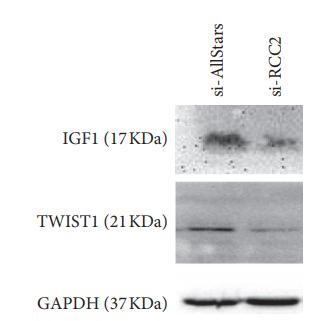Twist1 Antibody - #AF7945
| Product: | Twist1 Antibody |
| Catalog: | AF7945 |
| Description: | Rabbit polyclonal antibody to Twist1 |
| Application: | WB |
| Cited expt.: | WB |
| Reactivity: | Human |
| Prediction: | Pig, Bovine, Sheep, Chicken |
| Mol.Wt.: | 21kDa; 21kD(Calculated). |
| Uniprot: | Q15672 |
| RRID: | AB_2844308 |
Related Downloads
Protocols
Product Info
*The optimal dilutions should be determined by the end user.
*Tips:
WB: For western blot detection of denatured protein samples. IHC: For immunohistochemical detection of paraffin sections (IHC-p) or frozen sections (IHC-f) of tissue samples. IF/ICC: For immunofluorescence detection of cell samples. ELISA(peptide): For ELISA detection of antigenic peptide.
Cite Format: Affinity Biosciences Cat# AF7945, RRID:AB_2844308.
Fold/Unfold
ACS3; B-HLH DNA binding protein; bHLHa38; BPES2; BPES3; Class A basic helix-loop-helix protein 38; CRS; CRS1; CSO; H-twist; OTTHUMP00000116043; SCS; TWIST; Twist basic helix loop helix transcription factor 1; Twist family bHLH transcription factor 1; Twist homolog 1 (Drosophila); Twist homolog 1; TWIST homolog of drosophila; Twist related protein 1; Twist-related protein 1; TWIST1; TWST1_HUMAN;
Immunogens
A synthesized peptide derived from human Twist1, corresponding to a region within the internal amino acids.
- Q15672 TWST1_HUMAN:
- Protein BLAST With
- NCBI/
- ExPASy/
- Uniprot
MMQDVSSSPVSPADDSLSNSEEEPDRQQPPSGKRGGRKRRSSRRSAGGGAGPGGAAGGGVGGGDEPGSPAQGKRGKKSAGCGGGGGAGGGGGSSSGGGSPQSYEELQTQRVMANVRERQRTQSLNEAFAALRKIIPTLPSDKLSKIQTLKLAARYIDFLYQVLQSDELDSKMASCSYVAHERLSYAFSVWRMEGAWSMSASH
Predictions
Score>80(red) has high confidence and is suggested to be used for WB detection. *The prediction model is mainly based on the alignment of immunogen sequences, the results are for reference only, not as the basis of quality assurance.
High(score>80) Medium(80>score>50) Low(score<50) No confidence
Research Backgrounds
Acts as a transcriptional regulator. Inhibits myogenesis by sequestrating E proteins, inhibiting trans-activation by MEF2, and inhibiting DNA-binding by MYOD1 through physical interaction. This interaction probably involves the basic domains of both proteins. Also represses expression of proinflammatory cytokines such as TNFA and IL1B. Regulates cranial suture patterning and fusion. Activates transcription as a heterodimer with E proteins. Regulates gene expression differentially, depending on dimer composition. Homodimers induce expression of FGFR2 and POSTN while heterodimers repress FGFR2 and POSTN expression and induce THBS1 expression. Heterodimerization is also required for osteoblast differentiation. Represses the activity of the circadian transcriptional activator: NPAS2-ARNTL/BMAL1 heterodimer (By similarity).
Nucleus.
Subset of mesodermal cells.
Research Fields
· Human Diseases > Cancers: Overview > Proteoglycans in cancer.
References
Application: WB Species: Sample: MCF-7 cells
Restrictive clause
Affinity Biosciences tests all products strictly. Citations are provided as a resource for additional applications that have not been validated by Affinity Biosciences. Please choose the appropriate format for each application and consult Materials and Methods sections for additional details about the use of any product in these publications.
For Research Use Only.
Not for use in diagnostic or therapeutic procedures. Not for resale. Not for distribution without written consent. Affinity Biosciences will not be held responsible for patent infringement or other violations that may occur with the use of our products. Affinity Biosciences, Affinity Biosciences Logo and all other trademarks are the property of Affinity Biosciences LTD.
